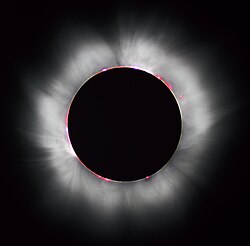


The stellar atmosphere is the outer region of the volume of a star, lying above the stellar core, radiation zone and convection zone.
The stellar atmosphere is divided into several regions of distinct character:
During a total solar eclipse, the photosphere of the Sun is obscured, revealing its atmosphere's other layers.[1] Observed during eclipse, the Sun's chromosphere appears (briefly) as a thin pinkish arc,[11] and its corona is seen as a tufted halo. The same phenomenon in eclipsing binaries can make the chromosphere of giant stars visible.[12]
On ordinary days, the corona is hidden by the blue sky, since it is about a million times fainter than the layer of the sun we see shining every day, the photosphere.
this opaque layer is the photosphere, the level of the Sun from which we get our light and heat
100 km suggested by average models
Now most scientists believe that the heating of the corona is linked to the interaction of the magnetic field lines.
The dominant color is influenced by the Balmer radiation of atomic hydrogen
{{cite book}}: |journal= ignored (help)
|
| ||
|---|---|---|
| Stars |
| |
| Planets |
| |
| Dwarf planets |
| |
| Natural satellites |
| |
| Exoplanets |
| |
| See also |
| |
Atmospheres in boldface are significant atmospheres; atmospheres in italics are unconfirmed atmospheres. | ||
|
| |||||||
|---|---|---|---|---|---|---|---|
| |||||||
| Formation |
| ||||||
| Evolution |
| ||||||
| Classification |
| ||||||
| Nucleosynthesis |
| ||||||
| Structure |
| ||||||
| Properties |
| ||||||
| Star systems |
| ||||||
| Earth-centric observations |
| ||||||
| Lists |
| ||||||
| Related |
| ||||||
| |||||||